Critical Analysis of Management Theory and Practices Essay
VerifiedAdded on 2020/03/16
|10
|2832
|50
Essay
AI Summary
This essay critically analyzes two perspectives in management theory: strategic choice and the deterministic approach, considering their relevance to future market trends. The essay explores how organizations can either control their environment through strategic decisions or adapt to market changes. It examines the role of strategic planning, decision-making, and the influence of internal and external factors on organizational structure and strategy. The analysis delves into the components of strategic choice, including authenticity, communicability, believability, and deliverability. It also discusses the deterministic approach, including resource dependency, chance, and institutional theory. Ultimately, the essay assesses the applicability of both approaches in the context of a dynamic market environment, highlighting the importance of adaptability and proactive management strategies for long-term organizational sustainability.
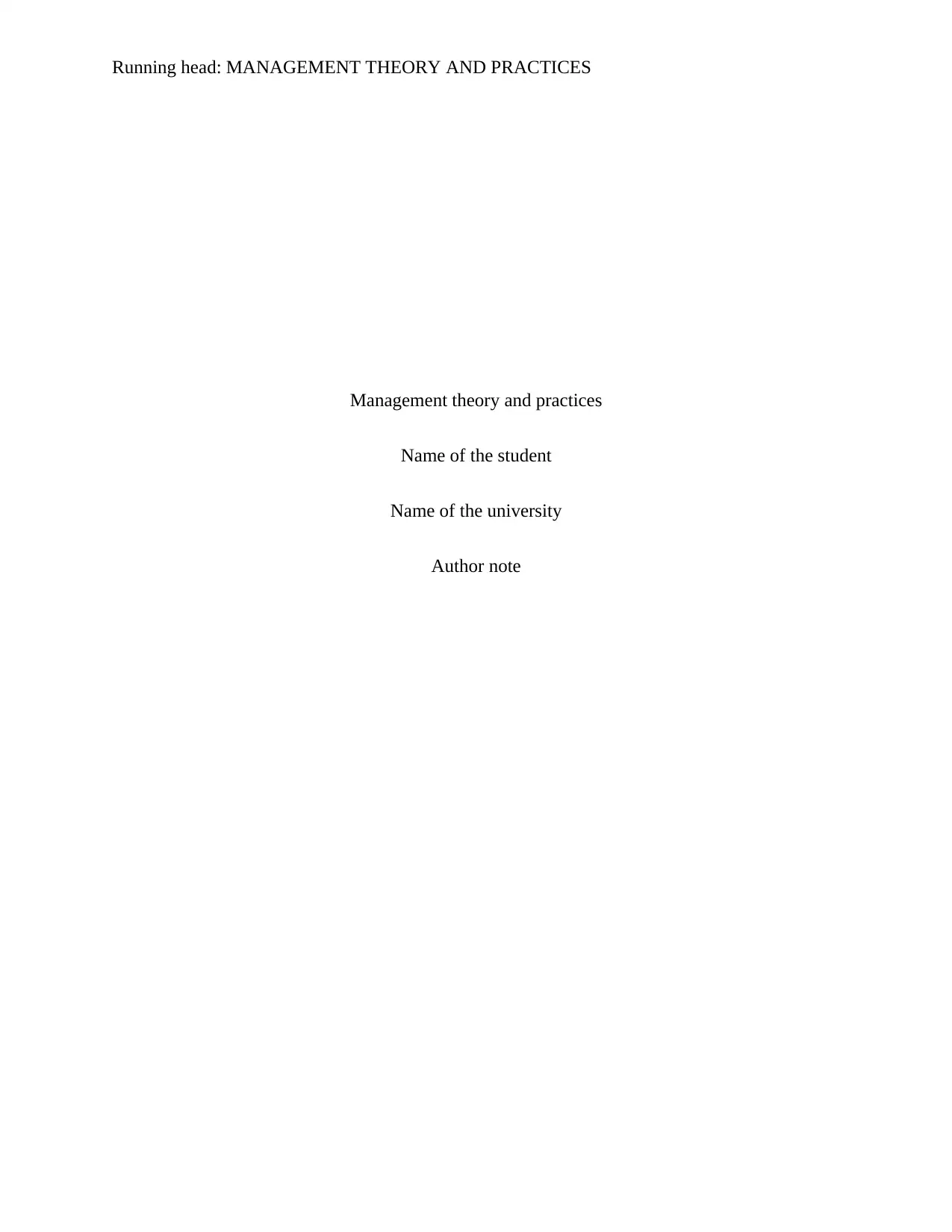
Running head: MANAGEMENT THEORY AND PRACTICES
Management theory and practices
Name of the student
Name of the university
Author note
Management theory and practices
Name of the student
Name of the university
Author note
Paraphrase This Document
Need a fresh take? Get an instant paraphrase of this document with our AI Paraphraser

1MANAGEMENT THEORY AND PRACTICES
Globalization has changed the perspectives of most of the organization and many
companies in the market are using innovative strategies to handle the uncertainties in the market.
However, there are two perspectives that have been taken into consideration by the companies in
the market: one is the strategic choice and the other is the deterministic approach. The
deterministic theory believes that the market has its own sets of control (Pisano 2017). Thus,
many organizations are trying to make use of the strategy and respond to the changes in the
market. These companies continuously observe the changes in the market situation so that they
quickly adapt to the changes. The identification of the patterns in the market is important in this
perspective because it will facilitate the organizations in capitalizing on the market situations.
The industry, social environment and the market place will determine the structuring of the
organization. However, this concept has not been widely accepted and majority of the companies
are following the strategic choice approach (Tokman, Richey and Deitz 2016). Strategic choice
is an approach which states that the organization have the same amount of control of the market
environment and the customers. The organizations can predict the future trends to identify the
strategies that have to be applied. This predictive helps the organization to be prepared for the
uncertainties so that the changes in the market environment will not affect the organization.
Moreover, the organization can control the market by changing the strategies in pricing,
networking and advertising. This shows that the organizations are more focused on the
preventative measures than the counter measures (Strong et al. 2014). This essay will critically
analyze both the perspectives to identify which will be appropriate for the future trends in the
market.
The central factor to making strategic decision is the process of strategic choice, which is
effective. The management has a degree of discretion, which means that they have the choice of
Globalization has changed the perspectives of most of the organization and many
companies in the market are using innovative strategies to handle the uncertainties in the market.
However, there are two perspectives that have been taken into consideration by the companies in
the market: one is the strategic choice and the other is the deterministic approach. The
deterministic theory believes that the market has its own sets of control (Pisano 2017). Thus,
many organizations are trying to make use of the strategy and respond to the changes in the
market. These companies continuously observe the changes in the market situation so that they
quickly adapt to the changes. The identification of the patterns in the market is important in this
perspective because it will facilitate the organizations in capitalizing on the market situations.
The industry, social environment and the market place will determine the structuring of the
organization. However, this concept has not been widely accepted and majority of the companies
are following the strategic choice approach (Tokman, Richey and Deitz 2016). Strategic choice
is an approach which states that the organization have the same amount of control of the market
environment and the customers. The organizations can predict the future trends to identify the
strategies that have to be applied. This predictive helps the organization to be prepared for the
uncertainties so that the changes in the market environment will not affect the organization.
Moreover, the organization can control the market by changing the strategies in pricing,
networking and advertising. This shows that the organizations are more focused on the
preventative measures than the counter measures (Strong et al. 2014). This essay will critically
analyze both the perspectives to identify which will be appropriate for the future trends in the
market.
The central factor to making strategic decision is the process of strategic choice, which is
effective. The management has a degree of discretion, which means that they have the choice of
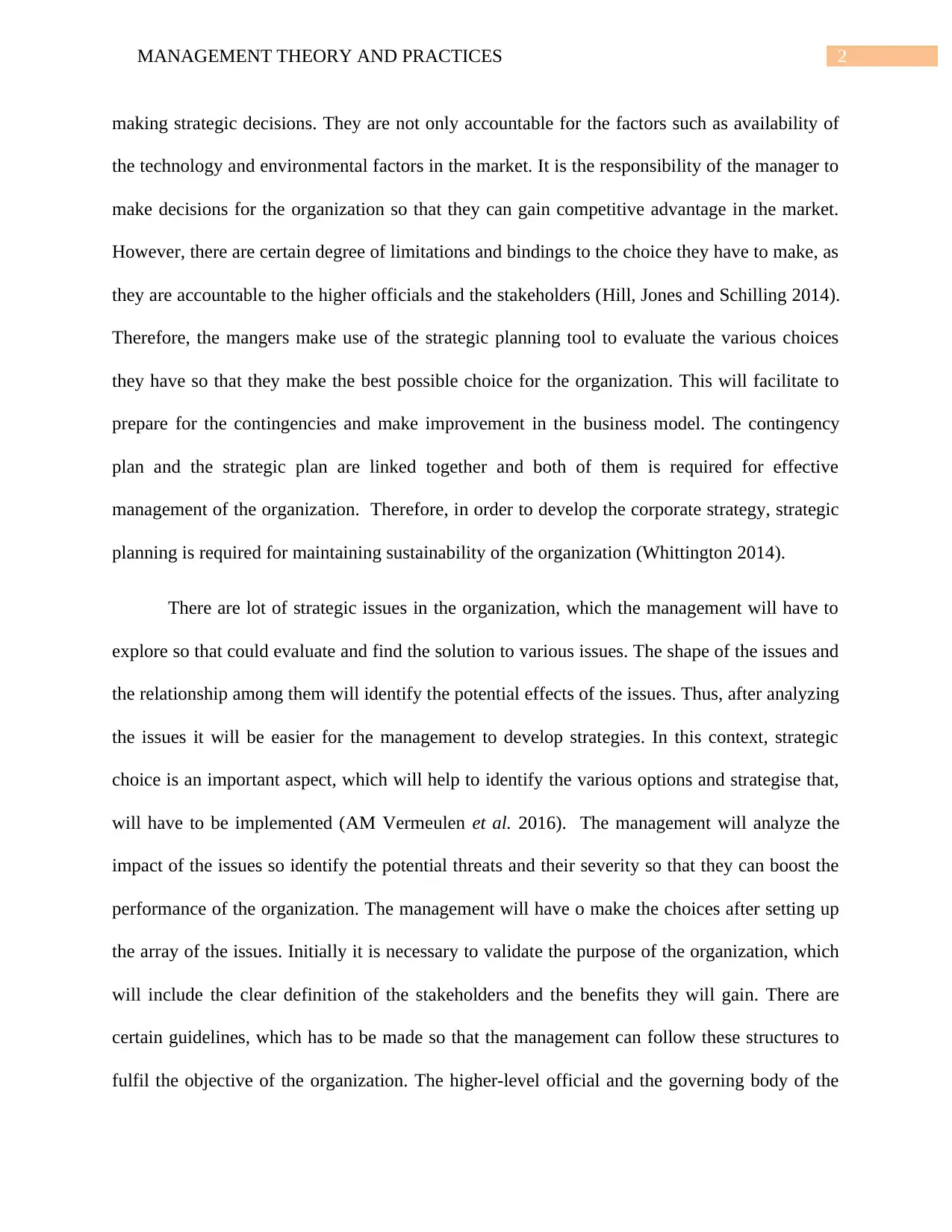
2MANAGEMENT THEORY AND PRACTICES
making strategic decisions. They are not only accountable for the factors such as availability of
the technology and environmental factors in the market. It is the responsibility of the manager to
make decisions for the organization so that they can gain competitive advantage in the market.
However, there are certain degree of limitations and bindings to the choice they have to make, as
they are accountable to the higher officials and the stakeholders (Hill, Jones and Schilling 2014).
Therefore, the mangers make use of the strategic planning tool to evaluate the various choices
they have so that they make the best possible choice for the organization. This will facilitate to
prepare for the contingencies and make improvement in the business model. The contingency
plan and the strategic plan are linked together and both of them is required for effective
management of the organization. Therefore, in order to develop the corporate strategy, strategic
planning is required for maintaining sustainability of the organization (Whittington 2014).
There are lot of strategic issues in the organization, which the management will have to
explore so that could evaluate and find the solution to various issues. The shape of the issues and
the relationship among them will identify the potential effects of the issues. Thus, after analyzing
the issues it will be easier for the management to develop strategies. In this context, strategic
choice is an important aspect, which will help to identify the various options and strategise that,
will have to be implemented (AM Vermeulen et al. 2016). The management will analyze the
impact of the issues so identify the potential threats and their severity so that they can boost the
performance of the organization. The management will have o make the choices after setting up
the array of the issues. Initially it is necessary to validate the purpose of the organization, which
will include the clear definition of the stakeholders and the benefits they will gain. There are
certain guidelines, which has to be made so that the management can follow these structures to
fulfil the objective of the organization. The higher-level official and the governing body of the
making strategic decisions. They are not only accountable for the factors such as availability of
the technology and environmental factors in the market. It is the responsibility of the manager to
make decisions for the organization so that they can gain competitive advantage in the market.
However, there are certain degree of limitations and bindings to the choice they have to make, as
they are accountable to the higher officials and the stakeholders (Hill, Jones and Schilling 2014).
Therefore, the mangers make use of the strategic planning tool to evaluate the various choices
they have so that they make the best possible choice for the organization. This will facilitate to
prepare for the contingencies and make improvement in the business model. The contingency
plan and the strategic plan are linked together and both of them is required for effective
management of the organization. Therefore, in order to develop the corporate strategy, strategic
planning is required for maintaining sustainability of the organization (Whittington 2014).
There are lot of strategic issues in the organization, which the management will have to
explore so that could evaluate and find the solution to various issues. The shape of the issues and
the relationship among them will identify the potential effects of the issues. Thus, after analyzing
the issues it will be easier for the management to develop strategies. In this context, strategic
choice is an important aspect, which will help to identify the various options and strategise that,
will have to be implemented (AM Vermeulen et al. 2016). The management will analyze the
impact of the issues so identify the potential threats and their severity so that they can boost the
performance of the organization. The management will have o make the choices after setting up
the array of the issues. Initially it is necessary to validate the purpose of the organization, which
will include the clear definition of the stakeholders and the benefits they will gain. There are
certain guidelines, which has to be made so that the management can follow these structures to
fulfil the objective of the organization. The higher-level official and the governing body of the
⊘ This is a preview!⊘
Do you want full access?
Subscribe today to unlock all pages.

Trusted by 1+ million students worldwide
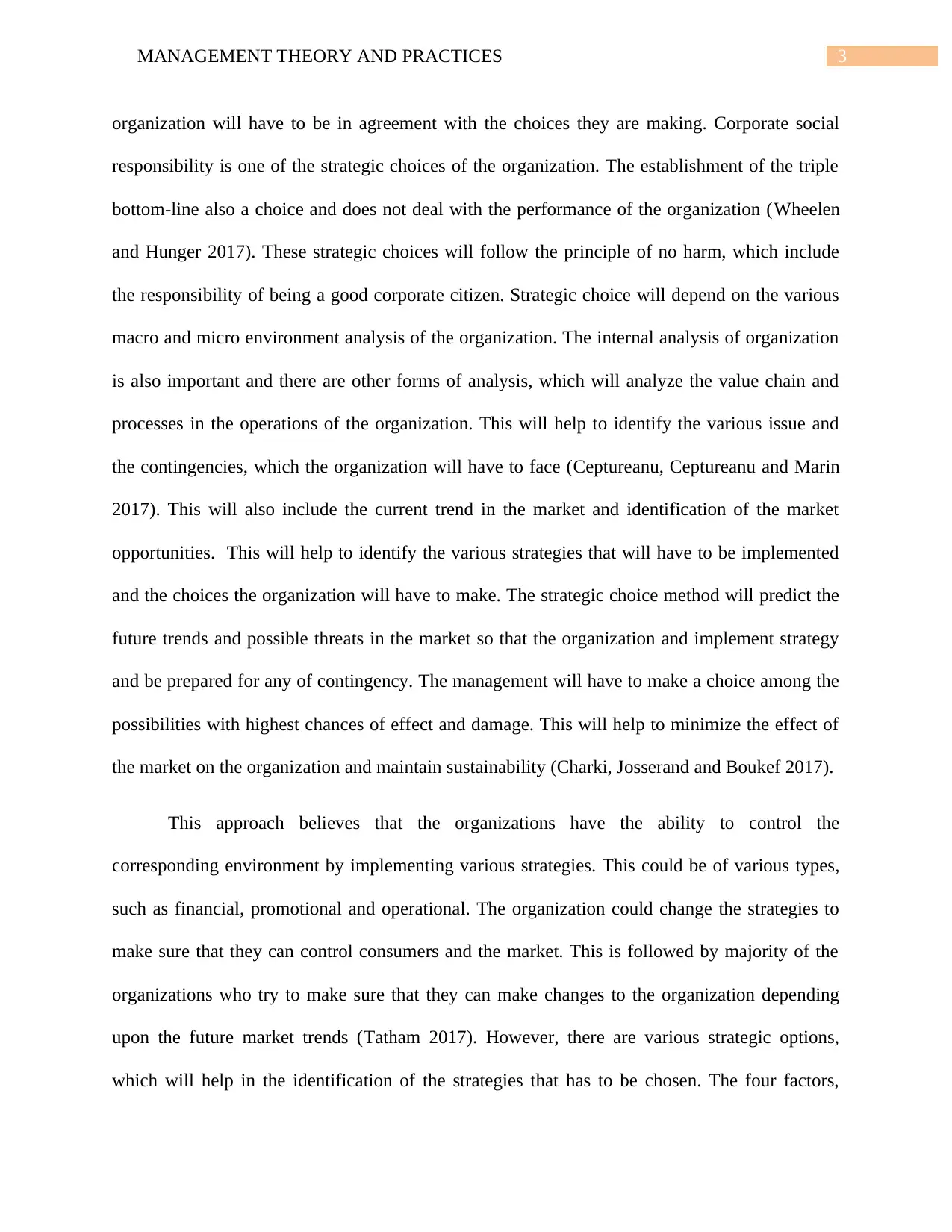
3MANAGEMENT THEORY AND PRACTICES
organization will have to be in agreement with the choices they are making. Corporate social
responsibility is one of the strategic choices of the organization. The establishment of the triple
bottom-line also a choice and does not deal with the performance of the organization (Wheelen
and Hunger 2017). These strategic choices will follow the principle of no harm, which include
the responsibility of being a good corporate citizen. Strategic choice will depend on the various
macro and micro environment analysis of the organization. The internal analysis of organization
is also important and there are other forms of analysis, which will analyze the value chain and
processes in the operations of the organization. This will help to identify the various issue and
the contingencies, which the organization will have to face (Ceptureanu, Ceptureanu and Marin
2017). This will also include the current trend in the market and identification of the market
opportunities. This will help to identify the various strategies that will have to be implemented
and the choices the organization will have to make. The strategic choice method will predict the
future trends and possible threats in the market so that the organization and implement strategy
and be prepared for any of contingency. The management will have to make a choice among the
possibilities with highest chances of effect and damage. This will help to minimize the effect of
the market on the organization and maintain sustainability (Charki, Josserand and Boukef 2017).
This approach believes that the organizations have the ability to control the
corresponding environment by implementing various strategies. This could be of various types,
such as financial, promotional and operational. The organization could change the strategies to
make sure that they can control consumers and the market. This is followed by majority of the
organizations who try to make sure that they can make changes to the organization depending
upon the future market trends (Tatham 2017). However, there are various strategic options,
which will help in the identification of the strategies that has to be chosen. The four factors,
organization will have to be in agreement with the choices they are making. Corporate social
responsibility is one of the strategic choices of the organization. The establishment of the triple
bottom-line also a choice and does not deal with the performance of the organization (Wheelen
and Hunger 2017). These strategic choices will follow the principle of no harm, which include
the responsibility of being a good corporate citizen. Strategic choice will depend on the various
macro and micro environment analysis of the organization. The internal analysis of organization
is also important and there are other forms of analysis, which will analyze the value chain and
processes in the operations of the organization. This will help to identify the various issue and
the contingencies, which the organization will have to face (Ceptureanu, Ceptureanu and Marin
2017). This will also include the current trend in the market and identification of the market
opportunities. This will help to identify the various strategies that will have to be implemented
and the choices the organization will have to make. The strategic choice method will predict the
future trends and possible threats in the market so that the organization and implement strategy
and be prepared for any of contingency. The management will have to make a choice among the
possibilities with highest chances of effect and damage. This will help to minimize the effect of
the market on the organization and maintain sustainability (Charki, Josserand and Boukef 2017).
This approach believes that the organizations have the ability to control the
corresponding environment by implementing various strategies. This could be of various types,
such as financial, promotional and operational. The organization could change the strategies to
make sure that they can control consumers and the market. This is followed by majority of the
organizations who try to make sure that they can make changes to the organization depending
upon the future market trends (Tatham 2017). However, there are various strategic options,
which will help in the identification of the strategies that has to be chosen. The four factors,
Paraphrase This Document
Need a fresh take? Get an instant paraphrase of this document with our AI Paraphraser

4MANAGEMENT THEORY AND PRACTICES
which will help in making the choice, are authenticity, communicability, believability and
deliverability (Ghosh, Ranganathan and Rosenkopf 2016). The choices that are made by the
organization must be authentic. In order to check the authenticity of a strategy the viable
alternatives to the organization will have to be found out. The strategic choice will help to
identify the things the organization is suppose to do and the things they are not suppose top do.
The limitations are equally important as it help to improve the business model of the
organization. The authentic choices will include the factors, which will help the organization to
compete so that the firm can gain competitive advantage in the market. The choice is believable
if the strategy consists of various facts and real time data that help to understand the feasibility.
The choices will have to be trustworthy, relevant and representative which will provide evidence
that the strategic choice is logical. This will validate the strategy that it can be implemented in
the particular organization setting (Pisano 2017). There are lot of opportunities, which are
illogical and not feasible for the organization so the believability is an important factor.
Communicability is another factor in making strategic choice, a strategy can be believable and
authentic but if not communicated in an effective manner then the implementation is not
possible. The management team implements all the strategies so it is essential o communicate all
the details so that they can understand and agree to the objective. The last factor that is important
for making the strategic choice is deliverability, even though the strategies have been evaluated,
validated and narrowed down, it important for the organization to make sure that they will be
able to execute the plan that has been suggested (Kelly 2013). Thus, the execution of the
strategies is most important factor because there are lot of strategies, which are not feasible for
the organization. The cost of the implementation of the strategy is a big factor; it may happen
that the cost of the strategy is more than the lifetime revenue that can be generated. In this
which will help in making the choice, are authenticity, communicability, believability and
deliverability (Ghosh, Ranganathan and Rosenkopf 2016). The choices that are made by the
organization must be authentic. In order to check the authenticity of a strategy the viable
alternatives to the organization will have to be found out. The strategic choice will help to
identify the things the organization is suppose to do and the things they are not suppose top do.
The limitations are equally important as it help to improve the business model of the
organization. The authentic choices will include the factors, which will help the organization to
compete so that the firm can gain competitive advantage in the market. The choice is believable
if the strategy consists of various facts and real time data that help to understand the feasibility.
The choices will have to be trustworthy, relevant and representative which will provide evidence
that the strategic choice is logical. This will validate the strategy that it can be implemented in
the particular organization setting (Pisano 2017). There are lot of opportunities, which are
illogical and not feasible for the organization so the believability is an important factor.
Communicability is another factor in making strategic choice, a strategy can be believable and
authentic but if not communicated in an effective manner then the implementation is not
possible. The management team implements all the strategies so it is essential o communicate all
the details so that they can understand and agree to the objective. The last factor that is important
for making the strategic choice is deliverability, even though the strategies have been evaluated,
validated and narrowed down, it important for the organization to make sure that they will be
able to execute the plan that has been suggested (Kelly 2013). Thus, the execution of the
strategies is most important factor because there are lot of strategies, which are not feasible for
the organization. The cost of the implementation of the strategy is a big factor; it may happen
that the cost of the strategy is more than the lifetime revenue that can be generated. In this

5MANAGEMENT THEORY AND PRACTICES
scenario, the strategy is not feasible for the organization and other alternatives have to be
evaluated.
The deterministic approach states that the any organization will have to change according
to the changes in the market conditions. This is due to the fact the companies in the market will
have to change along with the upcoming changes if they want to maintain their sustainability in
the market (Soni, Jain and Kumar 2014). The deterministic theory is not flexible or open to
change, they are rather forced to change. This means that the organization will have no control
over the market uncertainties and instead of taking preventative measures they will be forced to
adapt to the changes in the market. the resource dependency theory deals with the dependence
of the organization on the external resources. This can be the raw materials the organization uses
for making their products (Malatesta and Smith 2014). The market needs are changing and it is
an important concept in the deterministic theory as alteration in the raw materials is needed and
the organization who can make the transformation quickly will be the one to gain competitive
advantage in the market. There are organization who are dependent on their resources so it is
essential for them to control the raw materials. The dependency on a single source could be a
weakness so organizations try to manage their resources to maintain their long-term
sustainability. Thus, the strategy will have to be based on these theories so that it has a positive
impact on the organization. Chance will play an important role as it will affect the strategy of the
organization. The random events in the market could act in favour of the organization at the
same time it could have adverse effect on the organization. It may happen that various trivial
choices may lead to consequences that were never expected by the organization and similarly, it
may happen that some tight actions which were coupled together in a nice way will produce
scenario, the strategy is not feasible for the organization and other alternatives have to be
evaluated.
The deterministic approach states that the any organization will have to change according
to the changes in the market conditions. This is due to the fact the companies in the market will
have to change along with the upcoming changes if they want to maintain their sustainability in
the market (Soni, Jain and Kumar 2014). The deterministic theory is not flexible or open to
change, they are rather forced to change. This means that the organization will have no control
over the market uncertainties and instead of taking preventative measures they will be forced to
adapt to the changes in the market. the resource dependency theory deals with the dependence
of the organization on the external resources. This can be the raw materials the organization uses
for making their products (Malatesta and Smith 2014). The market needs are changing and it is
an important concept in the deterministic theory as alteration in the raw materials is needed and
the organization who can make the transformation quickly will be the one to gain competitive
advantage in the market. There are organization who are dependent on their resources so it is
essential for them to control the raw materials. The dependency on a single source could be a
weakness so organizations try to manage their resources to maintain their long-term
sustainability. Thus, the strategy will have to be based on these theories so that it has a positive
impact on the organization. Chance will play an important role as it will affect the strategy of the
organization. The random events in the market could act in favour of the organization at the
same time it could have adverse effect on the organization. It may happen that various trivial
choices may lead to consequences that were never expected by the organization and similarly, it
may happen that some tight actions which were coupled together in a nice way will produce
⊘ This is a preview!⊘
Do you want full access?
Subscribe today to unlock all pages.

Trusted by 1+ million students worldwide
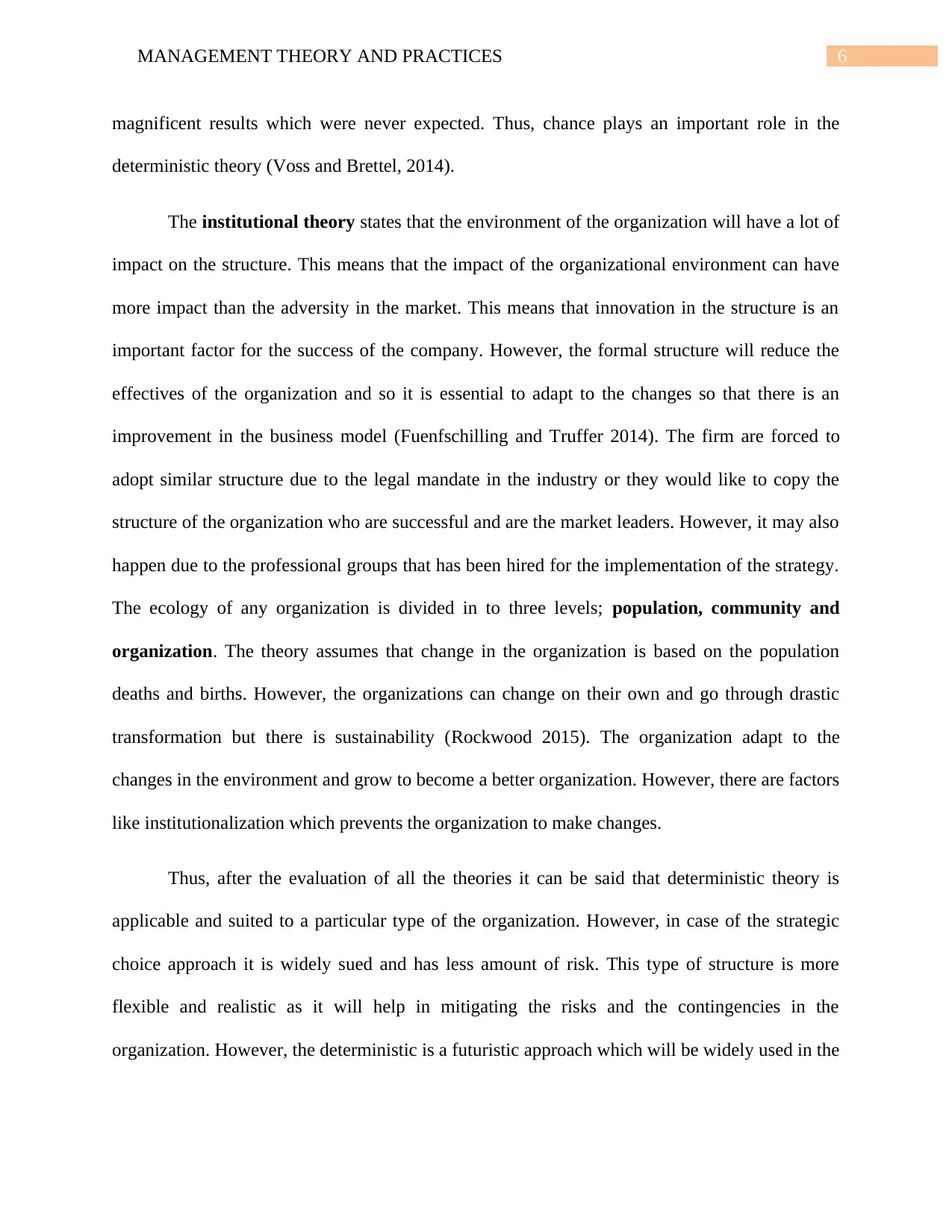
6MANAGEMENT THEORY AND PRACTICES
magnificent results which were never expected. Thus, chance plays an important role in the
deterministic theory (Voss and Brettel, 2014).
The institutional theory states that the environment of the organization will have a lot of
impact on the structure. This means that the impact of the organizational environment can have
more impact than the adversity in the market. This means that innovation in the structure is an
important factor for the success of the company. However, the formal structure will reduce the
effectives of the organization and so it is essential to adapt to the changes so that there is an
improvement in the business model (Fuenfschilling and Truffer 2014). The firm are forced to
adopt similar structure due to the legal mandate in the industry or they would like to copy the
structure of the organization who are successful and are the market leaders. However, it may also
happen due to the professional groups that has been hired for the implementation of the strategy.
The ecology of any organization is divided in to three levels; population, community and
organization. The theory assumes that change in the organization is based on the population
deaths and births. However, the organizations can change on their own and go through drastic
transformation but there is sustainability (Rockwood 2015). The organization adapt to the
changes in the environment and grow to become a better organization. However, there are factors
like institutionalization which prevents the organization to make changes.
Thus, after the evaluation of all the theories it can be said that deterministic theory is
applicable and suited to a particular type of the organization. However, in case of the strategic
choice approach it is widely sued and has less amount of risk. This type of structure is more
flexible and realistic as it will help in mitigating the risks and the contingencies in the
organization. However, the deterministic is a futuristic approach which will be widely used in the
magnificent results which were never expected. Thus, chance plays an important role in the
deterministic theory (Voss and Brettel, 2014).
The institutional theory states that the environment of the organization will have a lot of
impact on the structure. This means that the impact of the organizational environment can have
more impact than the adversity in the market. This means that innovation in the structure is an
important factor for the success of the company. However, the formal structure will reduce the
effectives of the organization and so it is essential to adapt to the changes so that there is an
improvement in the business model (Fuenfschilling and Truffer 2014). The firm are forced to
adopt similar structure due to the legal mandate in the industry or they would like to copy the
structure of the organization who are successful and are the market leaders. However, it may also
happen due to the professional groups that has been hired for the implementation of the strategy.
The ecology of any organization is divided in to three levels; population, community and
organization. The theory assumes that change in the organization is based on the population
deaths and births. However, the organizations can change on their own and go through drastic
transformation but there is sustainability (Rockwood 2015). The organization adapt to the
changes in the environment and grow to become a better organization. However, there are factors
like institutionalization which prevents the organization to make changes.
Thus, after the evaluation of all the theories it can be said that deterministic theory is
applicable and suited to a particular type of the organization. However, in case of the strategic
choice approach it is widely sued and has less amount of risk. This type of structure is more
flexible and realistic as it will help in mitigating the risks and the contingencies in the
organization. However, the deterministic is a futuristic approach which will be widely used in the
Paraphrase This Document
Need a fresh take? Get an instant paraphrase of this document with our AI Paraphraser
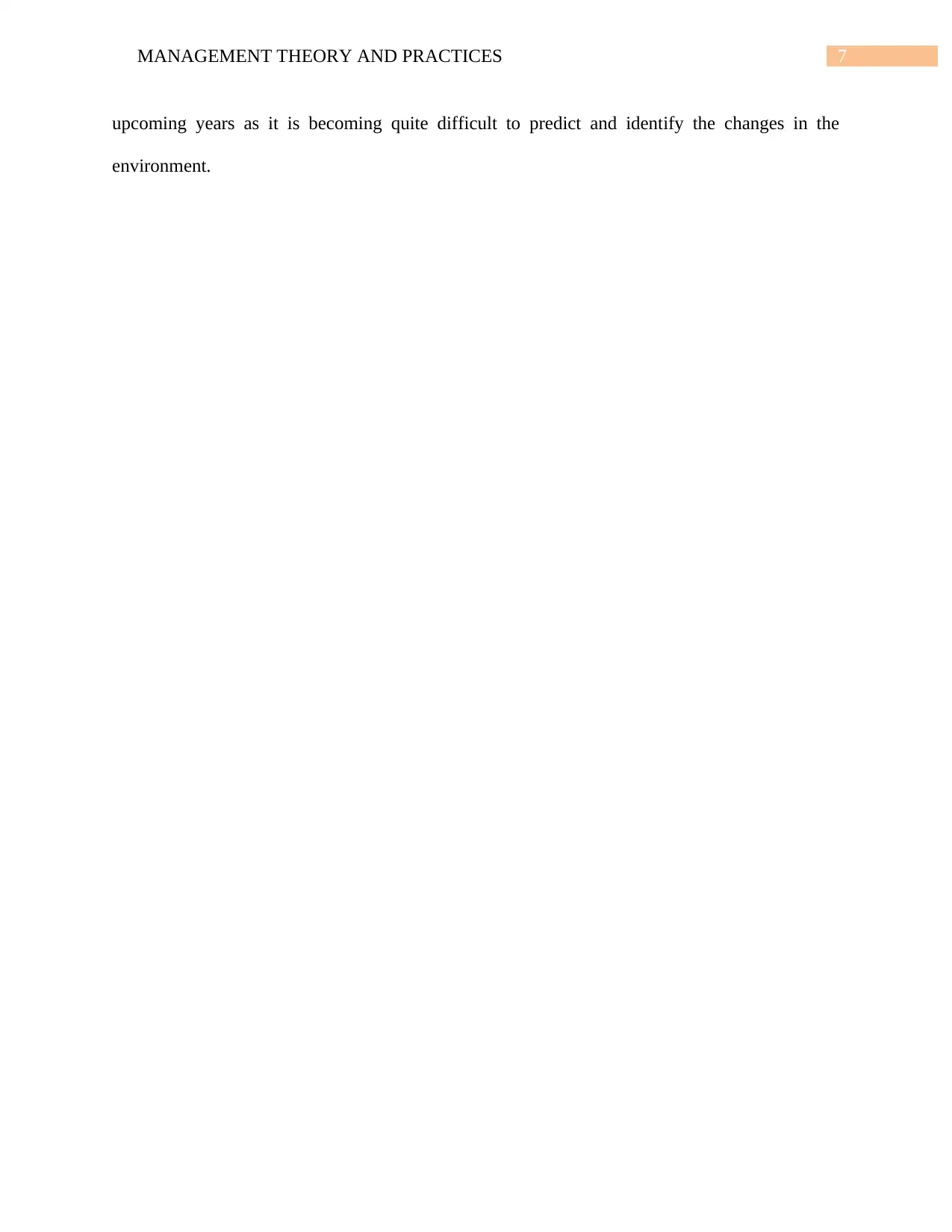
7MANAGEMENT THEORY AND PRACTICES
upcoming years as it is becoming quite difficult to predict and identify the changes in the
environment.
upcoming years as it is becoming quite difficult to predict and identify the changes in the
environment.
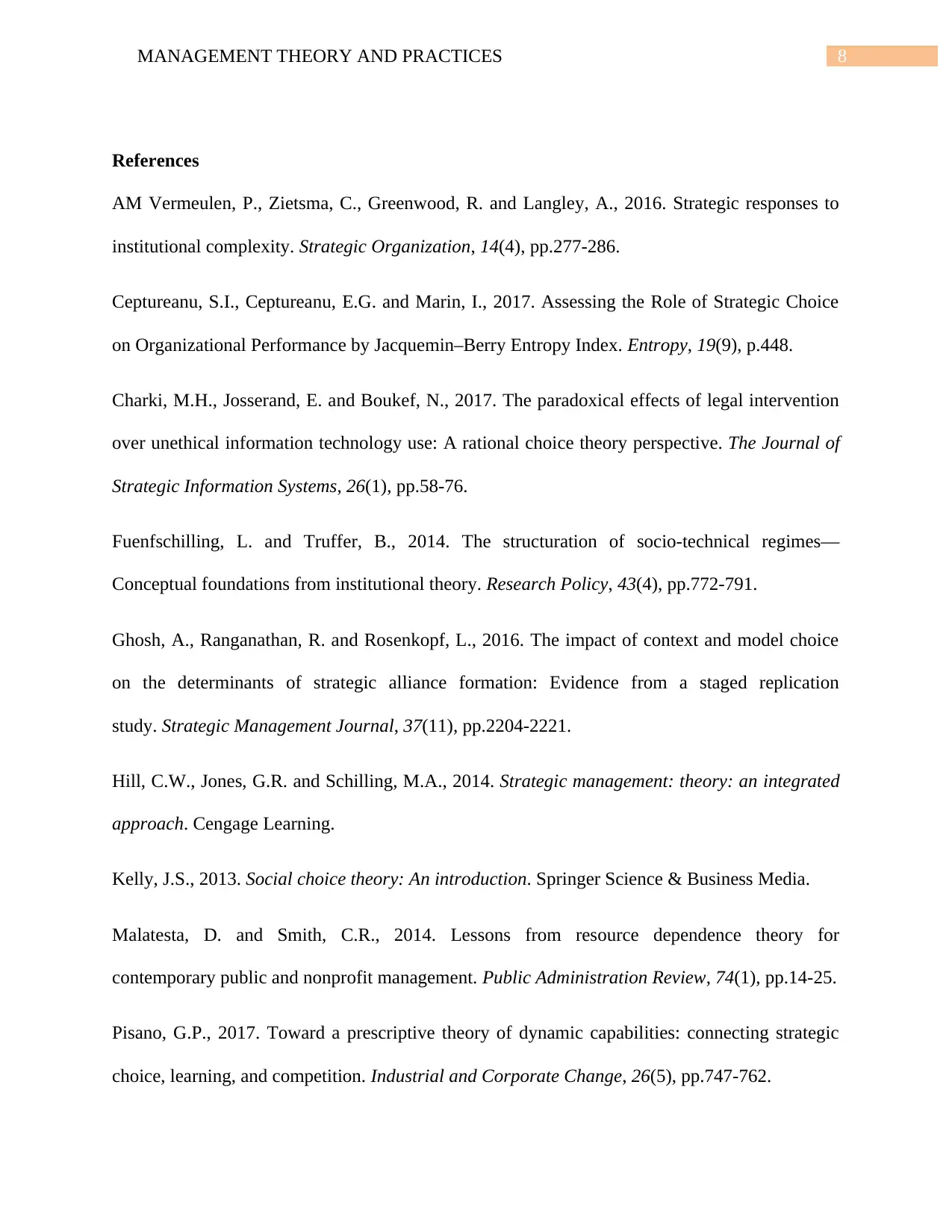
8MANAGEMENT THEORY AND PRACTICES
References
AM Vermeulen, P., Zietsma, C., Greenwood, R. and Langley, A., 2016. Strategic responses to
institutional complexity. Strategic Organization, 14(4), pp.277-286.
Ceptureanu, S.I., Ceptureanu, E.G. and Marin, I., 2017. Assessing the Role of Strategic Choice
on Organizational Performance by Jacquemin–Berry Entropy Index. Entropy, 19(9), p.448.
Charki, M.H., Josserand, E. and Boukef, N., 2017. The paradoxical effects of legal intervention
over unethical information technology use: A rational choice theory perspective. The Journal of
Strategic Information Systems, 26(1), pp.58-76.
Fuenfschilling, L. and Truffer, B., 2014. The structuration of socio-technical regimes—
Conceptual foundations from institutional theory. Research Policy, 43(4), pp.772-791.
Ghosh, A., Ranganathan, R. and Rosenkopf, L., 2016. The impact of context and model choice
on the determinants of strategic alliance formation: Evidence from a staged replication
study. Strategic Management Journal, 37(11), pp.2204-2221.
Hill, C.W., Jones, G.R. and Schilling, M.A., 2014. Strategic management: theory: an integrated
approach. Cengage Learning.
Kelly, J.S., 2013. Social choice theory: An introduction. Springer Science & Business Media.
Malatesta, D. and Smith, C.R., 2014. Lessons from resource dependence theory for
contemporary public and nonprofit management. Public Administration Review, 74(1), pp.14-25.
Pisano, G.P., 2017. Toward a prescriptive theory of dynamic capabilities: connecting strategic
choice, learning, and competition. Industrial and Corporate Change, 26(5), pp.747-762.
References
AM Vermeulen, P., Zietsma, C., Greenwood, R. and Langley, A., 2016. Strategic responses to
institutional complexity. Strategic Organization, 14(4), pp.277-286.
Ceptureanu, S.I., Ceptureanu, E.G. and Marin, I., 2017. Assessing the Role of Strategic Choice
on Organizational Performance by Jacquemin–Berry Entropy Index. Entropy, 19(9), p.448.
Charki, M.H., Josserand, E. and Boukef, N., 2017. The paradoxical effects of legal intervention
over unethical information technology use: A rational choice theory perspective. The Journal of
Strategic Information Systems, 26(1), pp.58-76.
Fuenfschilling, L. and Truffer, B., 2014. The structuration of socio-technical regimes—
Conceptual foundations from institutional theory. Research Policy, 43(4), pp.772-791.
Ghosh, A., Ranganathan, R. and Rosenkopf, L., 2016. The impact of context and model choice
on the determinants of strategic alliance formation: Evidence from a staged replication
study. Strategic Management Journal, 37(11), pp.2204-2221.
Hill, C.W., Jones, G.R. and Schilling, M.A., 2014. Strategic management: theory: an integrated
approach. Cengage Learning.
Kelly, J.S., 2013. Social choice theory: An introduction. Springer Science & Business Media.
Malatesta, D. and Smith, C.R., 2014. Lessons from resource dependence theory for
contemporary public and nonprofit management. Public Administration Review, 74(1), pp.14-25.
Pisano, G.P., 2017. Toward a prescriptive theory of dynamic capabilities: connecting strategic
choice, learning, and competition. Industrial and Corporate Change, 26(5), pp.747-762.
⊘ This is a preview!⊘
Do you want full access?
Subscribe today to unlock all pages.

Trusted by 1+ million students worldwide
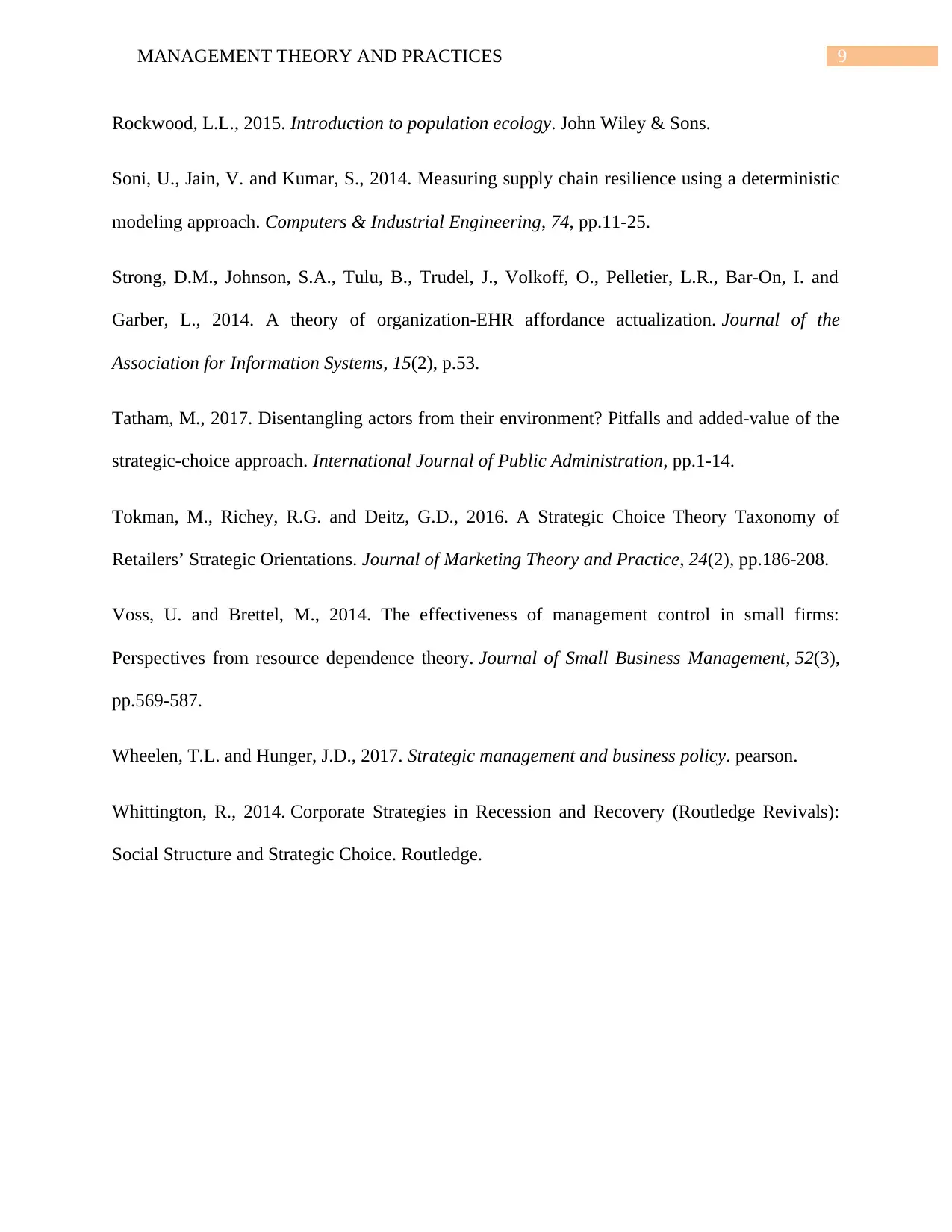
9MANAGEMENT THEORY AND PRACTICES
Rockwood, L.L., 2015. Introduction to population ecology. John Wiley & Sons.
Soni, U., Jain, V. and Kumar, S., 2014. Measuring supply chain resilience using a deterministic
modeling approach. Computers & Industrial Engineering, 74, pp.11-25.
Strong, D.M., Johnson, S.A., Tulu, B., Trudel, J., Volkoff, O., Pelletier, L.R., Bar-On, I. and
Garber, L., 2014. A theory of organization-EHR affordance actualization. Journal of the
Association for Information Systems, 15(2), p.53.
Tatham, M., 2017. Disentangling actors from their environment? Pitfalls and added-value of the
strategic-choice approach. International Journal of Public Administration, pp.1-14.
Tokman, M., Richey, R.G. and Deitz, G.D., 2016. A Strategic Choice Theory Taxonomy of
Retailers’ Strategic Orientations. Journal of Marketing Theory and Practice, 24(2), pp.186-208.
Voss, U. and Brettel, M., 2014. The effectiveness of management control in small firms:
Perspectives from resource dependence theory. Journal of Small Business Management, 52(3),
pp.569-587.
Wheelen, T.L. and Hunger, J.D., 2017. Strategic management and business policy. pearson.
Whittington, R., 2014. Corporate Strategies in Recession and Recovery (Routledge Revivals):
Social Structure and Strategic Choice. Routledge.
Rockwood, L.L., 2015. Introduction to population ecology. John Wiley & Sons.
Soni, U., Jain, V. and Kumar, S., 2014. Measuring supply chain resilience using a deterministic
modeling approach. Computers & Industrial Engineering, 74, pp.11-25.
Strong, D.M., Johnson, S.A., Tulu, B., Trudel, J., Volkoff, O., Pelletier, L.R., Bar-On, I. and
Garber, L., 2014. A theory of organization-EHR affordance actualization. Journal of the
Association for Information Systems, 15(2), p.53.
Tatham, M., 2017. Disentangling actors from their environment? Pitfalls and added-value of the
strategic-choice approach. International Journal of Public Administration, pp.1-14.
Tokman, M., Richey, R.G. and Deitz, G.D., 2016. A Strategic Choice Theory Taxonomy of
Retailers’ Strategic Orientations. Journal of Marketing Theory and Practice, 24(2), pp.186-208.
Voss, U. and Brettel, M., 2014. The effectiveness of management control in small firms:
Perspectives from resource dependence theory. Journal of Small Business Management, 52(3),
pp.569-587.
Wheelen, T.L. and Hunger, J.D., 2017. Strategic management and business policy. pearson.
Whittington, R., 2014. Corporate Strategies in Recession and Recovery (Routledge Revivals):
Social Structure and Strategic Choice. Routledge.
1 out of 10
Related Documents
Your All-in-One AI-Powered Toolkit for Academic Success.
+13062052269
info@desklib.com
Available 24*7 on WhatsApp / Email
![[object Object]](/_next/static/media/star-bottom.7253800d.svg)
Unlock your academic potential
Copyright © 2020–2025 A2Z Services. All Rights Reserved. Developed and managed by ZUCOL.




